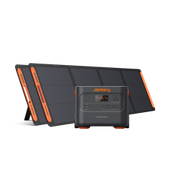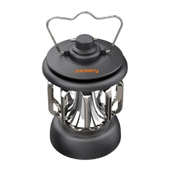The amperage of a standard ceiling fan running on a 120V voltage varies between 0.2 and 6 amps (low to high setting). To understand how many amps a ceiling fan uses, you should know its setting, cooling, motor efficiency, fan speed, voltage supply, fan load, and design.
In summer, fans contribute significantly to electricity bills compared to winter. Also, during hot, sizzling summers, there might be frequent blackouts, and for both scenarios, solar power generators like the Jackery Solar Generators are a reliable alternative. These solar generators are eco-friendly and renewable and offer long-lasting solar power to charge your fans both indoors and outdoors.
Key Takeaways
- The amperage consumption of a ceiling fan depends upon major factors such as the number of blades, fan speed/RPM, phase types, voltage, and power source.
- The amperage of a standard ceiling fan varies between 0.2 to 6 amps.
- When the ceiling fan is turned on, it draws a significant amount of power, which is required to start an idle compressor, known as surge wattage.
- Ceiling fans with the ENERGY STAR® label are 40% more efficient than the conventional models.

How Many Amps Does a Ceiling Fan Use
A 1200mm three-blade ceiling fan with 35 to 50 watts would draw 0.3 to 0.4 amps of amperage. Similarly, a 1050mm ceiling fan with 48 to 90 watts draws around 0.4 to 0.8 amps of current.
A 1300mm ceiling fan of 78 to 140 watts draws about 0.7 to 1.2 amps current, whereas a 1400mm ceiling fan of 60 to 85 watts would draw 0.5 to 0.7 amps current. A 600 mm ceiling fan of 50 to 80 watts draws about 0.4 to 0.6 amps amperage, and a 900 mm fan of 25 to 76 watts would draw 0.2 to 0.6 amps current.
Although the sweep size of the ceiling fan is just one of the primary factors, the amperage consumption of a ceiling fan depends upon other major factors as well. These factors include the number of blades, fan speed/RPM, phase types, voltage, and power source.
Definition of Amps, Volts, Watts, Running Watts
Ceiling fans and other electrical appliances operate using fundamental electrical principles like watts, amps, and volts. As you rely on a variety of electrical appliances, it is crucial to use them safely and efficiently. These concepts help you understand how many amps a ceiling fan uses and provide a deeper understanding of electrical units.
Amps (Amperes): Amps measure the amount of current flowing through a circuit and determine the amount of electricity being used by the ceiling fan. Higher amperage means the flow of current is high, thereby increasing power consumption. If you know the wattage of your ceiling fan operating at a specific voltage, you can calculate amps using the formula:
Amps = Watts ÷ Volts.
Volts: Voltage is the driving force in an electrical system and measures the pressure that pushes electrons in a conductor. Current cannot flow through a circuit without sufficient voltage, and ceiling fans and other appliances wouldn’t function. In the United States, most household electrical systems use AC voltage at 120V.
Volts = Watts ÷ Amps
Watts: Watts or wattage represents the rate at which energy is used. It is the unit of power, and one watt is equal to one joule of energy used per second. Wattage is directly related to performance, and hence, a ceiling fan with higher wattage would perform well considering other factors as well. Watts is given by the formula:
Watts = Volts × Amps.
Running Watts: Running wattage is often correlated with devices that need a steady flow of power during regular operation. Finding running wattage for running ceiling fans is crucial for managing costs and energy consumption.
Running Watts = Volts × Running Amps.
To understand power consumption in a detailed manner, you can refer to our guide on how many watts a ceiling fan uses and what measures you can take to save energy costs.
How Many Amps Does A Standard, Low-Profile, ENERGY STAR®, Dual-Motor, Smart, Outdoor, Commercial Ceiling Fans Use?
A standard ceiling fan of 75 to 100 watts would draw around 0.6 to 0.8 amps of current operating at 120V. A low-profile/bladeless ceiling fan, particularly used in kitchens and living rooms, consumes 0.3 to 0.5 amps and 40 to 60 watts.
Most Energy Star-certified ceiling fans of 48 to 52 watts draw around 0.4 amps of current, whereas a dual-motor ceiling fan of 50 to 150 watts draws 0.4 to 1.2 amps amperage. A smart ceiling fan of 28 to 35 watts consumes around 0.2 to 0.3 amps, and a commercial ceiling fan running at 100 to 120 watts draws around 0.8 to 1 amps amperage.
Here's a detailed comparison of the different types of ceiling fans and their wattage and amp usage:
|
Ceiling Fan Types |
Ceiling Fan Wattage |
Actual Energy Usage (Around ½ of ceiling fan Wattage) |
Amps ( = Watts / Volts) |
|
Standard Ceiling Fan |
75W-100W |
37W-50W |
0.6-0.8 Amps |
|
Low-Profile Ceiling Fan |
40W-60W |
20W-30W |
0.3-0.5 Amps |
|
ENERGY STAR® Ceiling Fan |
48W-52W |
24W-26W |
0.4-0.43 Amps |
|
Dual-Motor Ceiling Fan |
50W-150W |
25W-75W |
0.4-1.2 Amps |
|
Smart Ceiling Fan |
28W-35W |
14W-17W |
0.2-0.3 Amps |
|
Commercial Ceiling Fan |
100W-120W |
50W-60W |
0.8-1 Amps |
How Many Amps Does a Ceiling Fan Draw on a Startup?
On startup, a ceiling fan operating at a running wattage of 70 watts will have a starting wattage of around 150 watts and will draw 1.25 amps of current. When the ceiling fan is turned on, it draws a significant amount of power, which is required to start an idle compressor. This is referred to as surge wattage, which is higher than running wattage.
Starting Watts vs. Running Watts
As mentioned before, startup watts are the amount of power required to start the ceiling fan motor before it starts running steadily. Usually, the starting wattage is 2-3 times higher than the rated/running wattage. For example, if a ceiling fan has a running wattage of 50W, its startup wattage could be 150W.
The power supply should be strong enough to provide the surge wattage, although it lasts only a few seconds. The fan’s compressor and other components must also be running.
The power the ceiling fan requires after the motor/compressor starts running is referred to as running watts. This continuous power consumption may vary between 50W and 120W. Let's take an example to understand how to calculate running and startup wattage.
Consider a standard ceiling fan running at 120V and drawing 0.5 amps. Using the formula,
Running Watts = Voltage x Running Amps = 120V x 0.5A = 60W.
Startup Watts = Running Watts x 2.14 = 60W x 2.14 = 128.4W.
Note: We multiplied the running watts by 2.14 because the startup watts are typically 2 to 3 times higher than the running watts.
Startup Amps vs. Running Amps
Startup amps are similar to startup watts in that they signify a higher value when the ceiling fan is turned on. The running/rated amp is the amperage that the fan uses consistently after the surge phase and is usually lower than the surge requirement.
Startup Amps = Running Amps x 2.14 = 3A x 2.14 = 6.42A.
How to Calculate Your Ceiling Fan Amps
There are several ways to calculate the amps a ceiling fan uses. Knowing how to calculate ceiling fan amps is important to monitor energy consumption and analyze whether maintenance is required.
Various methods are being used to calculate the amps of ceiling fans, and they have various levels of accuracy. These methods also help to determine their compatibility with alternate power sources like solar-powered generators.
Method 1: Manufacturer Details: Energy Star Rating
Knowing the Energy Star rating from the manufacturer details/user manual is one of the simplest ways to determine the amperage of your ceiling fan. Every new appliance comes with a label or user manual mentioning the wattage and voltage. Using these values of watts and voltage, you can determine the amperage by doing simple calculations.
For instance, if your ceiling fan is rated 80W and 120V, then the amperage might be indicated in the user manual. This also prevents you from getting confused and getting dependent on any third-party device. By doing a simple calculation, you can find out the amperage consumed. Let’s say the ceiling fan consumes 60W and is plugged into a 120V outlet, then:
Amps = Watts ÷ Volts = 60W ÷ 120V = 0.5 amps.
Method 2: Determine the Amps From the Wattage
Another method is as easy as the previous method, and you can determine the amps of your ceiling fan by using the volts and watts values. For example, if a standard three-blade ceiling fan consumes 80W at 120V, then:
Amps = Watts ÷ Volts = 80W ÷ 120V = 0.6A.
Method 3: Ceiling Fan Clamp Meter
A clamp meter is a device used to measure current flowing through ceiling fans without disconnecting the wires. This means you can measure electrical current without directly contacting the conductor.
The meter is clamped around the wire carrying the current to the fan. While the current is carried, it creates a magnetic flow around it, and the sensor present in the clamp meter detects the magnetic field. The magnetic field in the meter is directly proportional to the current flowing, and hence, the meter uses this relationship to display the current value.
Tips to Save Your Electricity Bill
Ceiling fans, fans mounted to the wall, table fans, etc., are some of the circulating fans. Although ceiling fans are a major requirement of every household, especially in summer, making a few adjustments could save billions of dollars nationwide. To save costs on your electricity bills, you can follow these tips:
- According to the Department of Energy, raise the thermostat to about 4°F (-15.5oC) if you use air conditioning. Installing a fan in each room means you can avoid using your air conditioning altogether.
- Make sure your room's ceiling is at least 8 feet high. For the best performance, install the fan so that the blades are 7 to 9 feet above the floor.
- Opt for the one with a larger blade, as it will provide the same cooling as a smaller blade but with lower velocity.
- On average, ceiling fans with the ENERGY STAR® label are 40% more efficient than the conventional models.
- Make sure to clean the fan blades, capacitor, and motor regularly, as dust will accumulate with more usage. Turning off the fan when you are not using it can save a lot of energy.
Solar Generators For Fan
Other than ceiling fans, there are many alternatives, such as portable fans and coolers, which provide the same level of comfort when you are at home, living off-the-grid, or outdoors for any adventure. Using the Jackery Solar Generators to power your portable fan/cooler can be an efficient choice in terms of affordability, safety, and capacity.
Jackery Solar Generators are solar-power generators offering renewable sources of energy. As a solar power system, these combine solar panels and power stations. The solar panels capture sunlight when placed over the roof or on the ground outside. They have specialized monocrystalline solar cells meant to absorb the radiation. Solar panels convert the solar energy into electrical energy (DC) and transfer it to a power station to convert it into AC.
Jackery Solar Generator 300 Plus
The Jackery Solar Generator 300 Plus offers power on the go and comes with book-sized foldable solar panels. Featuring all-around safety, the solar generator can fit into your backpack, giving you infinite power for outdoor adventures. You can charge portable fans and even portable coolers using this solar generator.

Jackery Solar Generator 600 Plus
Weighing just 16.1 lbs, the Jackery Solar Generator 600 Plus has high-level outdoor durability and supports a variety of outdoor devices, such as portable fans and coolers. It is a lightweight and durable solar generator and also a go-to solar generator for all your outdoor adventures.

Jackery Solar Generator 1000 Plus
The Jackery Solar Generator 1000 Plus supports 99% of devices, including outdoor portable fans, portable coolers, and more. Ideal for home battery backup, the solar generator supports up to three add-on battery packs and is long-lastingly reliable. You can even charge your fan and other appliances while you are moving to have full access to the resources once you reach your destination.

|
Jackery Products |
Capacity & Output Watts |
Fan Running Time |
|
Jackery Solar Generator 300 Plus |
Capacity: 288Wh Rated Output: 300W |
Table Fan (17W): 14.4H Box Fan (50W): 5H Tower Fan (45W): 5.4H Portable Cooler (150W): 1.6H |
|
Jackery Solar Generator 600 Plus |
Capacity: 632Wh Rated Output: 800W |
Table Fan (17W): 31.6H Box Fan (50W): 10.7H Tower Fan (45W): 12H Portable Cooler (150W): 3.6H |
|
Jackery Solar Generator 1000 Plus |
Capacity: 1264.64Wh Rated Output: 2000W |
Table Fan (17W): 63.2H Box Fan (50W): 21.5H Tower Fan (45W): 23.8H Portable Cooler (150W): 7.1H |
FAQs
Can a ceiling fan be on a 15-amp circuit?
Yes, some ceiling fans can be wired in a 15-amp circuit. As a 15-amp circuit is a standard household circuit, you can put 2-4 ceiling fans on it.
How many amps is a normal ceiling fan?
A standard ceiling fan with a 3-blade running on 120V would draw around 0.6 to 0.8 amps of current. A normal ceiling fan usually has 75 to 100 watts.
What is a good power for a fan?
Traditional ceiling fans consume 75 to 100 watts of power, and Energy Star-rated fans consume nearly about 48 watts of power. A fan's power consumption depends upon various factors, such as fan speed, size, number of blades, and phase type.
How do I choose a powerful ceiling fan?
Choosing the right and most powerful ceiling fan depends on various factors, such as the size of the fan, the number of blades, energy efficiency, etc.
Conclusion
Making informed decisions about installing energy-efficient fans in your home is easy once you know how many amps a ceiling fan uses. Incorporating crucial tips can lead to a significant reduction in energy waste and electricity bills. There are a variety of ceiling fans in the market with energy-efficient motors and smart controls for automatic shut-off and airflow adjustments. You can even switch to a more sustainable solution by investing in solar power systems like the Jackery Solar Generator. These have reliable and long-lasting batteries to keep your fans running both indoors and outdoors.




















































































































Leave a comment